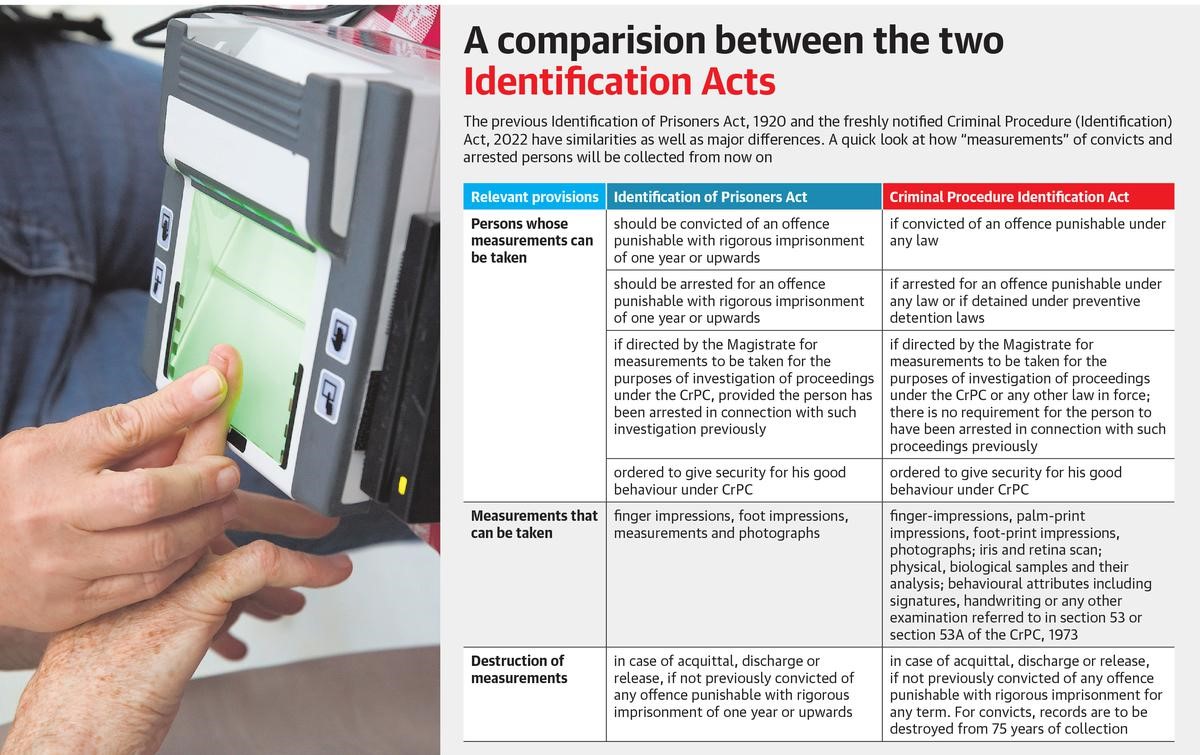Criminal Procedure (Identification) Act, 2022
Criminal Procedure (Identification) Act, 2022

Why in news?
The Criminal Procedure (Identification) Act, 2022 provides legal sanction to law enforcement agencies for “taking measurements of convicts and other persons for the purposes of identification and investigation of criminal matters”.
Highlights:
- While the legislation was enacted earlier this year, the Ministry of Home Affairs notified it to come into effect from August 4, 2022. It also repeals the existing Identification of Prisoners Act, 1920.
What is the use of identification details in criminal trials?
- Measurements and photographs for identification have three main purposes.
- to establish the identity of the culprit against the person being arrested,
- to identify suspected repetition of similar offences by the same person
- To establish a previous conviction.
What was the previous Identification of Prisoners Act, 1920?
- Even though the police has powers of arrest, mere arrest does not give them the right to search a person. The police requires legal sanction to search the person and collect evidence. These legal sanctions are designed so as to maintain a balance between the rights of an individual and the interests of society in prosecution and prevention of offences.
- The Identification of Prisoners Act, 1920 became a necessity when the recording of newer forms of evidence such as fingerprints, footprints and measurements started becoming more accurate and reliable.
- The Statement of Objectives and Reasons of the Identification of Prisoners Act, 1920 states that “the value of the scientific use of finger impressions and photographs as agents in the detection of crime and identification of criminals is well known”.
What was the need to replace this Act?
- Over the years, the need to amend/update the Identification of Prisoners Act, 1920 has been voiced several times.
- In 1980, the 87th Report of the Law Commission of India undertook a review of this legislation and recommended several amendments. This was done in the backdrop of the State of UP vs Ram Babu Misra case, where the Supreme Court had highlighted the need for amending this law.
- The first set of recommendations laid out the need to amend the Act to expand the scope of measurements to include “palm impressions”, “specimen of signature or writing” and “specimen of voice”.
- The second set of recommendations raised the need of allowing measurements to be taken for proceedings other than those under the Code of Criminal Procedure (CrPC).
- The Law Commission Report also notes that the need for an amendment is reflected by the numerous amendments made to the Act by several States. The Minister of Home Affairs, while laying the Criminal Procedure (Identification) Bill, 2022, in the Lok Sabha, observed that with advancements in forensics, there was a need to recognise more kinds of “measurements” that can be used by law enforcement agencies for investigation.
What are the main highlights and differences in both the legislations?
- Like the Identification of Prisoners Act, 1920, the new Criminal Procedure (Identification) Act, 2022 provides for legal sanction to law enforcement agencies for the collection of measurements.
- The purpose is to create a useable database of these measurements. While at the State level, each State is required to notify an appropriate agency to collect and preserve this database of measurements, at the national level, the National Crime Records Bureau (NCRB) is the designated agency to manage, process, share and disseminate the records collected at the State level.
What are some of the concerns with the present legislation?
- Since the Identification of Prisoners Act, 1920 was a colonial legislation, its duplication in the Criminal Procedure (Identification) Act, 2022, a post-independence legislation has raised some concerns related to the protection of fundamental rights.
- The legislation comes in the backdrop of the right to privacy being recognised as a fundamental right. A fundamental facet of the right to privacy is protection from the invasion of one’s physical privacy.
- As per the Puttaswamy judgment, for a privacy intrusive measure to be constitutional, there is a need for the measure to be taken in pursuance of a legitimate aim of the state, be backed by the law and be “necessary and proportionate” to the aim being sought to be achieved.
- It needs to be noted here that the new legislation allows that a person who has been arrested for an offence that is punishable by less than seven years of imprisonment, and is not an offence against women and children, “may not be obliged to allow taking of his biological samples”. This is definitely an improvement over the earlier law which did not allow for any such refusal.
- It also helps allay concerns of disproportionate collection. However, given the option to not submit for “measurements” is limited to biological samples and is available at the discretion of the police officer, this exception provides restricted relief.
- Another worry expressed by experts is that such collection can also result in mass surveillance, with the database under this law being combined with other databases such as those of the Crime and Criminal Tracking Network and Systems (CCTNS).
-
Lastly, concerns are being raised that the present law violates the right against self-incrimination enshrined in Article 20(3) of the Constitution of India. However, this argument is nebulous since the Supreme Court has already settled this point. In the State of Bombay vs Kathi Kalu Oghad, the Supreme Court had conclusively held that “non-communicative” evidence i.e. evidence which does not convey information within the personal knowledge of the accused cannot be understood to be leading to self-incrimination. Therefore, no challenge lies to the law on this ground.

